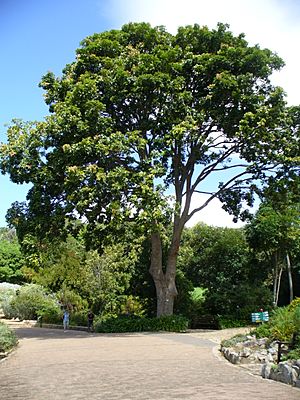Khaya anthotheca facts for kids
Quick facts for kids Khaya anthotheca |
|
|---|---|
 |
|
| Conservation status | |
| Scientific classification | |
| Genus: |
Khaya
|
| Species: |
anthotheca
|
| Synonyms | |
|
|
The East African mahogany (scientific name: Khaya anthotheca) is a very large tree. It belongs to the Meliaceae family, which is a group of flowering plants. This tree naturally grows in warm, tropical parts of Africa.
Its scientific name, anthotheca, comes from two ancient Greek words. Anthos means "flower," and theca means "capsule." This name likely refers to its flowers or seed pods. People also call this tree by other names, like Nyasaland mahogany, red mahogany, or white mahogany. In Afrikaans, it's called "Oos-Afrikaanse mahonie," and in French, it's known as "acajou."
Contents
Where East African Mahogany Grows
This amazing tree is found across a large part of Africa. You can find it from Guinea Bissau in the west, all the way east to Uganda and Tanzania. It also grows south into countries like Angola, Zambia, Zimbabwe, and Mozambique.
People often plant East African mahogany trees in special farms called plantations. These are found both in its natural home and in other places. For example, it grows in South Africa, tropical Asia, and tropical America. It can sometimes be hard to tell apart from other Khaya trees. These include K. grandifoliola, K. senegalensis, or K. ivorensis.
Where the Tree Lives
The East African mahogany tree likes to grow in places that are not too high up. It prefers evergreen forests, which are forests where trees keep their leaves all year. These trees need wet land to grow well.
One very famous East African mahogany is called the Big Tree. It is located in the Chirinda Forest Botanical Reserve in Zimbabwe. This giant tree is the tallest native tree in all of Zimbabwe!
What the East African Mahogany Looks Like
Khaya anthotheca trees can grow to be very tall. They often reach heights between 30 and 60 meters (about 100 to 200 feet). That's as tall as a 10 to 20-story building! Their bark is usually a greyish-brown color.
When the trees are fully grown, they produce beautiful white flowers. These flowers have a nice smell and grow at the very ends of the branches.
How People Use East African Mahogany
The wood from this tree is very useful. People use it to make many things, such as:
- Furniture for homes and offices
- Flooring for houses
- Paneling for walls
- Parts for building boats
- Musical instruments, like guitars
This wood is great for these projects because it lasts a long time. It can handle different weather conditions well. It is also strong and resists damage from wood-boring insects and termites. Plus, it doesn't easily get damaged by fungi. Even though it's tough, it's still easy to saw and work with.
The bark of the tree has a bitter taste. In some traditional practices, it has been used as a medicine for common colds. The oil from the seeds can also be rubbed on a person's head. This was sometimes done to help get rid of insects like lice.
Threats to the East African Mahogany
Sadly, the East African mahogany tree is often cut down in East and West Africa. People don't plant new trees very often to replace the ones that are destroyed. This means that the number of these trees is getting smaller.
Because of this, the species is listed as "vulnerable" on the IUCN Red List. This list tells us which plants and animals are at risk of disappearing. Some groups of these trees are now protected. Also, some countries have stopped people from exporting (sending out) this wood to other places. The leaves of the tree are also eaten by the larvae (young stage) of a moth called Heteronygmia dissimilis.
See also
 In Spanish: Khaya anthotheca para niños
In Spanish: Khaya anthotheca para niños


